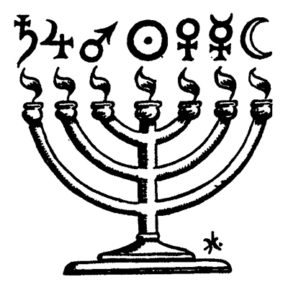All modern theology has its rise in the immeasurably old “number philosophy” of the ancient world.
The name JAH was given to our universe because it represented the number 16, which in turn was composed of 3+4=7 and 4+5 =9 (J=10, A=.1, H=5) . These two combinations are the two fundamental right angles of all geometry and the ones upon which most of our symbolism are founded.
The astounding recurrence of the number 7, not only in geometrical figures, but in countless curious objects of human speculation, caused it to be regarded with superstitious awe. It was regarded as one of good augury because most of the things beneficial to mankind came in series of sevens. When the ancient star gazers had finally determined the planets of our universe (those, of course, discernible to the naked eye), each item of the numerous septenary sets conceived of by our forefathers was attributed to the influence of one of the planets, deemed the dwelling of a superior intelligence active for the good or ill of humanity.

The Jewish seven-branched candlestick and its symbolism.
Thus the seven planets were the seven old gods of the Babylonians,- Shamash, the Sun; Sin, the Moon ; Nebo, Mercury, Ishtar, Venus, Nergal, Mars, Marduk, Jupiter and Ea, Saturn. They had other names as gods in nearly every oriental country. To the Hebrews they were the archangels Michael, Gabriel, Raphael, Samael, Uriel, Amiel, Zadkiel. To the early Christians they were the Angels of the Seven Churches. They were represented among the Jews, Babylonians, Egyptians, and Persians by seven branched candlesticks (Menorah) or seven-flamed altar fires.
A list of their supposed emanations would be almost interminable; but here are a few to go on with:
The seven vowels, primary colors, notes of music, metals, days of the week, liberal arts, rounds of the spiritual ladder or staircase, deadly sins, sorrows of the Virgin Mary ; the seven rays or Heptaktis of Jao Sabaoth among the Chaldeans ; the seven rays of Indra in Hindu Mythology ; the seven stars of the Pleiades, in Taurus ; the Seven Ages of Man, not invented by Shakespeare, but quoted by Solon, the Athenian lawgiver, and by the school of Hippocrates ; the seven Hyades, the seven stars of the Great Bear, forming a Swastika, in which the Hindus placed their seven Rishi or sages of primitive wisdom ; seven wonders of the world ; seven reeds to Pan’s pipe ; seven strings to Apollo’s Lyre ; seven gifts of the Holy Ghost ; seven champions of Christendom; seven sleepers of Ephesus ; seven Amshaspands of Persian theology, and seven Heavens.
The number 7 times 7 was still more sacred, and seven seven-pointed stars ornament the collar of a Grand Master of Masons under the York rite.
Of course there are a hundred more considerations of this interesting number; but almost all may be traced to different racial speculations on the same themes, derived from the contemplation by the ancient Sabeans of the seven planets of our universe.
Contents – The Beginning of Masonry
Previous – Three Times Three
Next – The Pi Proportion and Genesis
